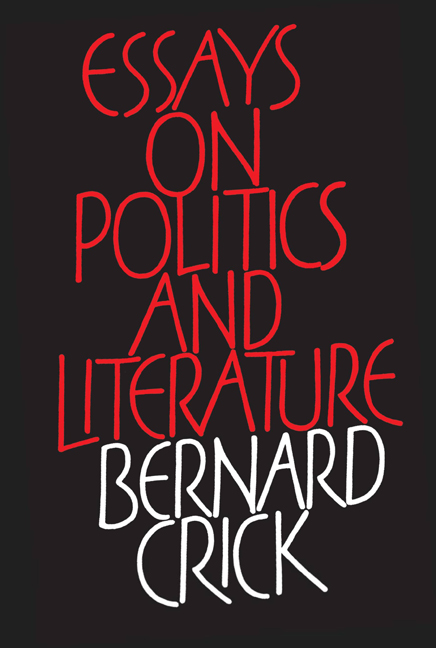Book contents
- Frontmatter
- Contents
- Preface
- Acknowledgements
- Foreword by David Daiches
- One Literature and Politics
- Two The Political in Britain’s Two National Theatres
- Three Young Writers of the Thirties
- Four Koestler’s Koestler
- Five Hannah Arendt: Hedgehog or Fox?
- Six Beatrice Webb as English Diarist
- Seven Words
- Eight My Lse
- Nine Reading The Observer as a Complex Text
- Ten On the Difficulties of Writing Biography and of Orwell’s in Particular
- Eleven Reading Nineteen Eighty-Four As Satire
- Twelve Animal Farm For Schools
- Thirteen Orwell and English Socialism
- Fourteen On the Orwell Trail
- Fifteen Wedekind’s Spring Awakening
- Sixteen Horvath’s Tales From the Vienna Woods
- Seventeen Pinter’s No Man's Land
- Eighteen Polly By Gaslight
- Nineteen Edgar Catches Jenkins’ Ear at the Barbican
- Twenty Barrault at the Barbican
- Index
Three - Young Writers of the Thirties
Published online by Cambridge University Press: 24 September 2020
- Frontmatter
- Contents
- Preface
- Acknowledgements
- Foreword by David Daiches
- One Literature and Politics
- Two The Political in Britain’s Two National Theatres
- Three Young Writers of the Thirties
- Four Koestler’s Koestler
- Five Hannah Arendt: Hedgehog or Fox?
- Six Beatrice Webb as English Diarist
- Seven Words
- Eight My Lse
- Nine Reading The Observer as a Complex Text
- Ten On the Difficulties of Writing Biography and of Orwell’s in Particular
- Eleven Reading Nineteen Eighty-Four As Satire
- Twelve Animal Farm For Schools
- Thirteen Orwell and English Socialism
- Fourteen On the Orwell Trail
- Fifteen Wedekind’s Spring Awakening
- Sixteen Horvath’s Tales From the Vienna Woods
- Seventeen Pinter’s No Man's Land
- Eighteen Polly By Gaslight
- Nineteen Edgar Catches Jenkins’ Ear at the Barbican
- Twenty Barrault at the Barbican
- Index
Summary
The MacSpaunday family album has been opened to the public at the National Portrait Gallery. The actual title of the exhibition is ‘Young Writers of the Thirties’. It's an important exhibition, but it is in fact much narrower and more personal than the title suggests. The director writes in a Foreword to the catalogue:
The last great writers to be celebrated in exhibitions at the National Portrait Gallery were Pepys and Boswell. Both these exhibitions were on a rather larger scale and offered the visitor a panorama of the life of their respective periods. Our objective on this occasion is quite different, and is more an extension of our aims in the permanent display: to show a number of great writers in relation to each other, and in the context of their literary achievements … We have chosen five writers from that extraordinary generation, four of them poets, and all of them men who had the most profound effect in their contempraries: Auden, Day Lewis, Isherwood, MacNeice and Spender. The varied way in which these five writers-who knew each other well but were no sense a group- responded to the problems of their age, and the effect of their particular preoccupations on the development of their work, is the subject of this exhibition.
As a political writer who is only a common reader of literature (a reversal of roles of most reviewers of this exhibition or of Samual Hynes's recent book, The Auden Generation: Literature and Politics in the 1930s), I quote at such pedantic length to raise at once the main questions begged by the assumptions of the exhibition makers. If the five are all ‘great writers’, not just distinguished and interesting writers, then the case is ready-made for treating them as the young writers of the thirties, or ‘as representatives’ (says the catalogue) of all the rest,. Even so, however, is part of their greatness having had a ‘profound effect’ on their contemporaries? Or in reflecting so well some of the concerns of what StephenSpender later called “the Divided Generation’?
- Type
- Chapter
- Information
- Essays on Politics and Literature , pp. 48 - 61Publisher: Edinburgh University PressPrint publication year: 2020

